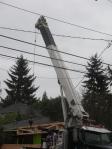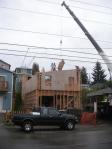Dan’s project was visited this week by a contractor interested in the Passive House concept. One of his concerns was of summer cooling. I thought that would be a good question to review. Even in Seattle we have been known to get temperatures over 100 deg F. Just an hour or so east of Seattle, on the other side of the Cascade mountains, residents regularly experience 100 deg days in the summer as well as plenty of snow in the winter. A Passive House being able to keep its residents comfortable year-round faces a bigger hurdle there than in Seattle, and yet it is held to the same Passive House requirements.
Even traditional house construction can teach us about a Passive House having the ability to keep us comfortable in the summer. Have you noticed that if you keep your house closed up on a summer day which you know will be quite hot, the house stays cooler than the outdoor air for a longer period? This is because the heat that made its way inside during the day before transferred out through radiation, conduction, or convection at night when the night-time temperatures were cooler. The next day as the outside was warmed by the sun, those same methods of heat transfer slowly heated up your house – but it took some time because of the insulation, orientation, or shading factors inherent in your house. Eventually if the day becomes hot enough, so does your house. Last year Seattle reached a record 103 deg F and more than one family wished for their own A/C unit!
In planning for a Passive House it is important to take into consideration what the temperatures are like year-round, not just for heating, but also for cooling. The good news is, the same careful construction planning that keeps you warm in a Passive House during the winter can also keep you cool during the summer. Proper insulation, orienting a house to get adequate Solar Heat Gain in the winter for warmth needs to be coupled with planning for summertime shading by way of overhangs, shading devices, as well as proper window selection. Knowing that winter sun arrives at a different angle than summer sun and planning for this is a key element of successful Passive House planning.
Choosing the right equipment and ways to operate the house also aids in keeping a comfortable summer environment. The ventilation system will run year-round to keep fresh air in the building, but the heat does not need to be recaptured year-round. Bypassing the heat recovery in the summer allows for excess heat in the house to be exhausted. Circulating air through earthtubes buried in the ground and then introducing that air (which not only pre-cools to approximately 50 deg F or so during the summer, but also pre-warms to that same temp in the winter) allows for another measure of climate control and is something that can be considered. Cooler night-time air circulated in the house is beneficial too. But what if these passive measures are not enough to keep a building comfortable in the summer? Is there anything I can do and still have a Passive House? The answer is yes. Just as Passive Houses have minor heating needs, some need just a bit of cooling and that can be provided through a mechanical device such as a mini-split air conditioner. The power requirements of this device need to be considered in the Passive House requirements, but with planning it can be done.
In Europe there is a group that is studying how construction requirements for Passive Houses in warm climates differ from those in cooler climates. They have made some recommendations that are not currently part of the Passive House requirements, but a lot of thought has already been put into that concern for Europe. As we move ahead in the US with Passive House construction we will learn more ways of improving the methods of construction to allow for both adequate heating AND cooling for our climatic regions. If you would like to read more about the European study, you can find information at http://www.passive-on.org/en/ While their solutions may not be directly applicable to our climate regions, the fact that Passive Houses can be successfully built-in a variety of climates is the important thought to take away. Wherever the project is, no matter the climate, all circumstances that will affect that project need to be considered and planned for to have a successful Passive House project.
Read More











Recent Comments